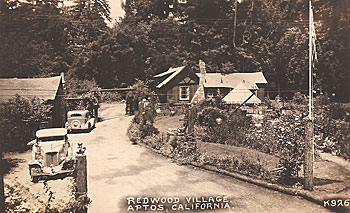The Unique History of Aptos’ own Redwood Grove
By Kevin Newhouse

We would go to the Piggie Market (commonly referred to as “Piggies”), located in Redwood Village, because it was the closest spot to get our fix of beef jerky, candy bars, and soda pop. It was true 5-star dining for a 12-year-old boy. This is why I am not surprised that visiting Redwood Village still brings a smile to my face today.
My experience is not unique. For more than 200 years, the Redwood Village has attracted visitors and locals who seek the blissful nature of the land. Mission Santa Cruz was founded in 1791 and today’s Soquel Drive was the Mission Trail that connected Santa Cruz with the other Missions along the El Camino Real including Mission San Juan Bautista, Mission San Carlos Borromeo de Carmelo, and the Presidio of Monterey.
In 1872, Claus Spreckels, the “Sugar King” of the Pacific Coast purchased a large quantity of land from Rafael Castro and built his enormous 2-story ranch home facing Soquel Drive. The west windows of his home commanded a view of the circle of redwoods. In 1925, 17 years after Spreckels’ death, Monroe, Lyon and Miller acquired his land and began to sub-divide. In 1928, A. Raymond Parker (who went by Raymond or Ray) also noticed the redwood cathedral and decided to purchase the land to build the Redwood Village Lodge.
The redwood grove was thinned and the timber was milled to construct the cottages. Parker designed his motel using a unique vernacular design with each cabin handcrafted and designed to fit into the redwood grove. A center gazebo was used for dancing. He created elegant Dutch doors for the buildings and constructed a fishpond to enhance the beautiful landscape. Every detail in his structure suggests that Parker was more than just a carpenter … he was also an artist. Parker died in 1939 and his widow, Mabel, sold the property in 1940. The motel was a popular place until after World War II when it began to experience a decline in users.
Redwood Village Lodge continued to operate as a motel, changing ownership several times, until Tony Oliveira purchased the site in 1974. The motel was abandoned in favor of retail use that put 15 independent businesses into the cottages. In addition to creating the only such vernacular shopping center in the county, 1974 was also the year the bridge over Aptos Creek was capped. The covered bridge, which is just short of 90 feet long, connects one end of Redwood Village to Soquel Drive. It was originally used as an entrance to the village. Throughout the years, the bridge has been used for antique shows and special events. Today, the bridge is no longer open to vehicle traffic, but one can still walk across it.
Redwood Village has changed ownership over the years but continues to thrive as a retail/office center. The unique woodland shops and offices tucked away in the quaint, rustic village are unlike anywhere else in the county. The Piggie Market closed its doors in 2008 but the Aptos Junior High School students still make the daily pilgrimage to Redwood Village to frequent The Palm Deli, which opened in August 2009 in the old Piggies building.
•••
For more information about the Aptos History Museum, upcoming events, or becoming a member of the museum, please visit www.aptoshistory.org.